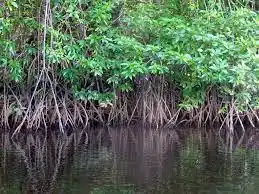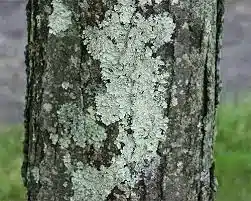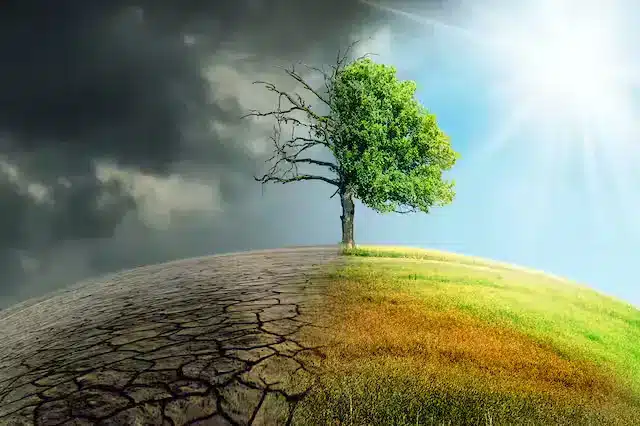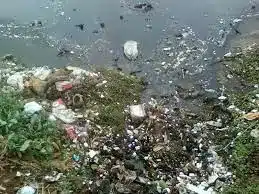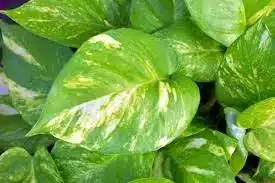Trophic Levels| Food Chain | Food Web
Trophic Levels
- A trophic level is the representation of energy flow in an ecosystem.
- The trophic level of an organism is the position it occupies in a food chain.
- Trophic level interaction deals with how the members of an ecosystem are connected based on nutritional needs.
| Autotrophs | Green plants (Producers) |
| Heterotrophs | Herbivore (Primary consumers) |
| Heterotrophs | Carnivores (Secondary consumers) |
| Heterotrophs | Carnivore (Tertiary consumers) |
| Heterotrophs | Top carnivores (Quaternary consumers) |
- Energy flows through the trophic levels from producers to subsequent trophic levels is unidirectional.
- Energy level decreases from the first trophic level upwards due to loss of energy in the form of heat at each trophic level.
- This energy loss at each trophic level is quite significant. Hence there are usually not more than four-five trophic levels (beyond this the energy available is negligible to support an organism).
- The trophic level interaction involves three concepts namely
- Food Chain
- Food Web
- Ecological Pyramids
Food Chain
- Transfer of food energy from green plants (producers) through a series of organisms with repeated eating and being eaten link is called a food chain. E.g. Grasses → Grasshopper → Frog → Snake → Hawk/Eagle.
- Each step in the food chain is called trophic level.
- A food chain starts with producers and ends with top carnivores.
- The trophic level of an organism is the position it occupies in a food chain.
- Types of Food Chains: 1) Grazing food chain and 2) Detritus food chain
Know About Ecological Succession
Grazing food chain
- The consumers which start the food chain, utilising the plant or plant part as their food, constitute the grazing food chain.
- For example, in a terrestrial ecosystem, the grass is eaten by a caterpillar, which is eaten by lizard and lizard is eaten by a snake.
- In Aquatic ecosystem phytoplankton (primary producers) are eaten by zooplanktons which are eaten by fishes and fishes are eaten by pelicans.
Detritus food chain
- This type of food chain starts from organic matter of dead and decaying animals and plant bodies from the grazing food chain.
- Dead organic matter or detritus feeding organisms are called detrivores or decomposers.
- The detrivores are eaten by predators.
- In an aquatic ecosystem, the grazing food chain is the major conduit for energy flow.
- As against this, in a terrestrial ecosystem, a much larger fraction of energy flows through the detritus food chain than through the grazing food chain.
Difference
- In the grazing food chain, the primary source of energy is living plant biomass while in the detritus food chain the source of energy is dead organic matter or detritus.
Food Web
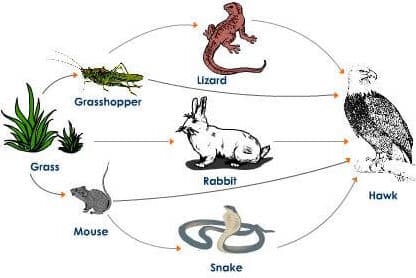
- Multiple interlinked food chains make a food web.
- Food web represents all the possible paths of energy flow in an ecosystem.
- If any of the intermediate food chains is removed, the succeeding links of the chain will be affected largely.
- The food web provides more than one alternative for food to most of the organisms in an ecosystem and therefore increases their chance of survival.
Types of Biotic Interactions in a Food Web
‘0’ is no effect; ‘–’ is detrimental; ‘+’ is beneficial.
| Type of interaction | Species | Effect | Comments | |
| Amensalism | – | 0 | One species is inhibited while the other species is unaffected. | A large tree shades a small plant, retarding the growth of the small plant. The small plant has no effect on the large tree. |
| Predation | + | – | One species (predator) benefits while the second species (prey) is harmed and inhibited. | Predators like leopards, tigers and cheetahs use speed, teeth and claws to hunt and kill their prey.Predators help in maintaining species diversity in a community, by reducing the intensity of competition among competing prey species. |
| Parasitism | + | – | Beneficial to one species (parasite) and harmful to the other species (host). | Parasitism involves parasite living in or on another living species called the host. The parasite gets its nourishment and often shelter from its host. Tap worm, roundworm, malarial parasite, many bacteria, fungi, and viruses are common parasites of humans. |
| Competition | – | – | Adversely affects both species. | Competition occurs when two populations or species, both need a vital resource that is in short supply. |
| Commensalism | + | 0 | One species (the commensal) benefits, while the other species (the host) is neither harmed nor inhibited | Suckerfish often attaches to a shark. This helps the suckerfish get protection, a free ride as well as a meal from the leftover of the shark’s meal. The shark does not, however, get any benefit nor is it adversely affected by this association. |
| Mutualism | + | + | Interaction is favourable to both species | The corals and algae have a mutualistic relationship. The coral provides the algae with a protected environment and compounds they need for photosynthesis. In return, the algae produce oxygen and help the coral to remove wastes. |
| Neutralism | 0 | 0 | Neither species affects the other | True neutralism is extremely unlikely. |
Know about ecological pyramids.
Also, refer :
- Download the pdf of Important MCQs From the History Of Ancient India
- List Of Important Inscriptions In India

